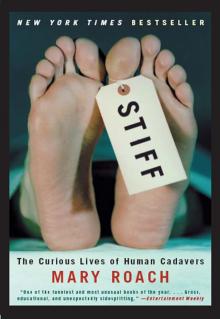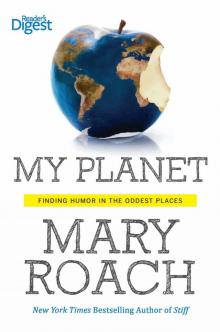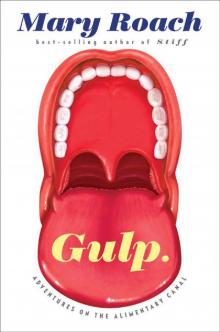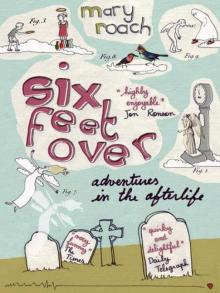- Home
- Mary Roach
My Planet: Finding Humor in the Oddest Places Page 6
My Planet: Finding Humor in the Oddest Places Read online
Page 6
Pesticide companies understand the husband-wife ant dynamic. Many have a separate line that emphasizes the nontoxic quality of the products, which is quite a bold marketing move for what is essentially a weapon of mass destruction.
One company tries to make ant death seem like a holiday in France. They have a product called Ant Café, so that rather than picturing the little guys gasping and writhing, you picture them sipping bowls of café au lait, smoking Gitanes and leafing through Le Figaro, which is hard to do at the same time unless, like the ant, you have six hands.
The last spray bottle Ed brought home was a brand called Safer’s. He read to me from the label, pausing now and again to make ant pâté on the counter. “It combines bait with borax,” he said, as though this made any kind of sense, as though helping them have whiter whites had always been the idea. “Fresh Mint Odor, honey!”
I’ve never encountered this kind of fresh mint odor. Imagine smelling some mint that’s growing on the lawn of a petrochemical plant. It’s that kind of fresh mint odor. When Ed wasn’t looking, the Safer’s went away on a holiday in France.
For a long time, Ed didn’t say much about the ants and I thought he’d made his peace with them. Then I found some of those little ant cups that leak brown, sticky, evil stuff and do not match our décor. He thought I’d like this idea, because no spraying and dying-on-the-countertops was involved. “They take the poison home and die there!” Ed said cheerfully.
I did not like the idea and I said so. So we had a little argument about the ant cups. Things may have gotten a tiny bit out of hand. I may have threatened to get some “jerk cups” and put them out in the places Ed goes to feed. A door slammed at some point. The ants watched for a while, and then fled for their lives. We haven’t seen them since.
Mr. Fix-It-Later
Kitchen renovation is a virus that preys upon the middle-aged homeowner. We caught it from our friends Dave and Kate, who caught it from Bill and Adair, who got it from reading magazines like Martha Stewart Living. We didn’t have the requisite $20,000 on hand, so Ed announced he’d build the cabinets himself. I recall the moment clearly, the way people recall where they were when JFK was shot or the Mets won the ’69 World Series.
Let me give you some perspective here. Our bathroom faucet is enameled with faux porcelain that has begun to chip off. Early in 1996, Ed purchased a tube of something called Porc-a-Fix, intending to fill in the chips. I came across the Porc-a-Fix, unopened and in its original packaging, inside a kitchen drawer recently. So long had it been that I no longer recalled the original purpose of the product and took it to be some sort of ham seasoning.
Ed looked at the tube. “I’ll get to that this weekend,” he said. Home repair projects around our house generally fall into two categories: “I’ll get to that this weekend” and “I’ll get to that this summer.” Followed by an eventual shift to a third category: “I’ll get the Yellow Pages.”
Make no mistake, my husband is a highly competent man. He has laid hardwood floors, put up walls, installed skylights. Most of this he did during a period of unemployment in his 20s. These days he works a full-time job, and thus spends his time off avoiding anything that sounds like work. If woodworking were called, say, “relaxing with wood,” things might actually get built.
The other problem is that guy Norm Abram. Abram hosts the PBS show Yankee Workshop, which is misleading, because you picture Nathan Hale stooped in some low-ceilinged, poorly lit Connecticut basement. When in reality, Norm Abram’s workshop is the size of the Vatican. Norm has every power tool ever invented. His workshop is airy and bright and well heated.
“Now I’m just going to walk over here and switch on my laminate trimmer,” Norm will say, and men across America go, “Yes! I’m going to go switch on my laminate trimmer too!” And then they get to the basement and their wives have laundry on the workbench, and mice are living in the biscuit joiner, and it’s cold and dank, and upstairs the Cubs are playing the Marlins, and that is pretty much that. In the case of the kitchen cabinet project, it’s not Norm’s fault. It’s Charlie’s. Charlie is a friend of Ed’s, who recently—in the time it would take Ed to unearth the cordless drill and go find batteries for it, make a sandwich, see if the Cubs are still ahead and nod off on the sofa—redid his kitchen.
I pointed out that Charlie is retired.
“Good idea,” said Ed. He was all set to retire too. “With all the money we’ll be saving by making our own furniture, why . . .”
I reminded Ed about the marble-top sideboard incident. Some years back, Ed found a piece of marble at a bargain price somewhere and decided to build a dining room sideboard around it. This required the purchase of a lathe and the aforementioned biscuit joiner, plus all the wood: an outlay of some $500. If he’d actually made the thing, we might still have come out ahead. Instead we came out with a slab of marble and some costly rodent housing.
I try to get Ed to focus on smaller projects—for instance, picture framing. Three years ago he took me up on this and bought a miter box and a mount cutter. For three years now, photographs and artwork have been piling up in the den. Every now and then, you hear them talking to one another as you pass by.
“How long you been waiting here?”
“ ’Bout a year. But I hear he’s got the miter box and everything. Just the other day I heard him say he’s going to get to it this weekend.”
The Beer and Bacon Diet
The chickens were the first to go. Ed—Ed’s my husband—had read something about the hormones they’re injected with. “They’re growing breasts!” he said with great alarm. I could not see the problem here.
“They’re chickens, honey,” I said. “That’s their job.”
Ed was envisioning some sort of biotech nightmare: vamping hens in training bras and eye shadow. From now on, he decreed, we were to buy only free-range organic chickens. Ed would put them in the shopping cart. I’d look at the price and take them out. “Are we eating them or putting them through college?” I said.
Beef went next. Because I used to write for a health magazine, I had heard about Mad Cow disease back when it was known by its scientific nomenclature, bovine spongebob empopalopathy. I got the entire family worked into a frenzy. I’d hold up a slice of Swiss cheese and say, “Your brain looks just like this!” I might have overdone it. One day when Ed brought his daughter Phoebe to the office, a co-worker asked, “How are you, Phoebe?” Phoebe was eight at the time. “I have Mad Cow disease,” she said.
To avoid Mad Cow, I’m told, you should eat only organic grass-fed beef. These cows are not raised in pens or fed commercial feed. They go to the same college as the free-range chickens.
So that left fish, but not for long. Sometime last year, there was a story in the news about mercury levels in ocean-caught fish. They made it sound like you could pick up a tuna and put its tail under your tongue and a little silver bar would shoot up the side and tell you if you had a fever. (Of course you can’t do this, because a tuna tail is too big to fit under your tongue.) I started buying fish-farm fish, but Ed hadn’t recovered from his chickens-with-bosoms fright. “You don’t know what they’re feeding them,” he said.
He turned out to be right. Six months later came a report about PCBs in farm-raised salmon. Apparently they feed them fish meal made from ground-up fish that feed in polluted parts of the Atlantic. “They feed fish fish!” I said and immediately regretted it. Soon we’d be reading about piscine spongebob empopalopathy.
I was about to reprise my Swiss cheese demonstration, but then I realized I’d thrown the cheese away because it contains dairy fats. These are saturated fats that raise your bad cholesterol level. Bad cholesterol is the kind that clogs arteries, shoplifts lipsticks and lies under oath.
So Ed and I were eating a lot of vegetables. Vegetables on pasta, vegetables on rice. This was extremely healthy, until you got to the part where Ed
and I are found in the kitchen at 10 p.m., feeding on Froot Loops and tubes of cookie dough.
Next the Atkins diet hit, and carbohydrates became evil and fattening. So we had to abandon the rice and pasta too.
It finally happened: Everything we could afford to eat was bad for us. For dinner last week, we ate steamed vegetables and a tiny piece of Alaskan river salmon. These fish come from pristine waters where prospectors once panned for gold, until salmon became more valuable. The hunger set in while I was loading the dishwasher. We had no snack foods or breakfast cereals to appease our hunger, because they contain transfats and high-fructose corn syrup, which cause your arteries to race around the block and tie themselves in knots.
Ed rummaged through the freezer. He found some bacon in the back. It had been so long since we’d had bacon that we couldn’t recall what was bad about it, so we fried it up fast before we remembered.
Then Ed took out two beers. I told him I’d read something about breast cancer levels and alcohol.
He said he wasn’t a chicken, twisted off the cap, and raised the bottle. “To your health!”
Menu Madness
You always know when a waiter is about to recite the specials. It’s like that awkward moment in a musical when the lead guy is about to break into song again. Everyone around him tries to be polite, but inside they’re going, “NOOO!!! Be a normal person!” NOOO! Just write it on a chalkboard!
Last week I went to a restaurant where they don’t recite specials. They actually write it all down. Unfortunately, they write it in a mixture of Italian and food-ese, necessitating a half-hour vocabulary lesson. I don’t do well in these places. I’m happiest in a restaurant that calls its sauces Louis, or “red.” I don’t want to know which organic farm the produce grew up on, and I don’t want to hear the adjective heirloom unless I’m watching Antiques Roadshow. Do you know what you’ve got here? It’s a tomato. It’s worth about $45. . . .
I was out at a new Italian place with some girlfriends last week. We were thinking of ordering an antipasto platter, which included “House-made salumi.”
“You’ve got a typo here,” said Adair to the waiter.
He replied that, no, salumi meant “cured meat.” “Salumi is the generic category. Salami is salumi, but salumi is not salami.” Soon someone would be breaking into song about how they say “tomato,” and I’d have to leave.
Kathy ordered first. She was considering the “Bigoli all’amatriciana with house-cured guanciale.” She happened to know that guanciale was pork cheek, and for some reason felt this was a plus. She asked the waiter what Bigoli was. He said Bigoli was the name of the pasta machine.
So we consulted amongst ourselves. We didn’t want to be rude. “And . . . what comes out of the machine tonight?”
“It’s an extruded pasta.” It was spaghetti. Spaghetti with red sauce. Talk about cheek.
Adair ordered next. She had some questions about the rabbit. The menu described it as “Rosemary-braised rabbit with rabbit offal spiedino.”
“What is offal spiedino?” said Adair, accenting the second syllable of each word, so as to suggest she spoke Italian. The waiter said that spiedino meant “on skewers.”
“Yes, but what’s on the skewers? What is oh-fall?”
“Heart, kidneys and liver wrapped in pancetta and . . .”
Offal was offal.
The lesson being taught here is that it is better not to ask. If you ask, then you run the risk of knowing. For instance, we now also know that hanger steak is cut from “the muscle that pushes the food from one stomach to the other.”
My other beef—sorry, complaint—with menu language is that the hyphen is underused, often with alarming consequences. For instance, in the phrase “Grilled Potter Family Farm beef heart,” what is grilled? The Potter family? Their farm? Whose heart is it? The cow’s or Mr. Potter’s?
I have seen with my own two eyes a menu offering “Mesquite grilled alligator pepper crusted pork tenderloin.” Fortunately, by the time I got to the end of the phrase, I’d forgotten the beginning of it, so it was just some pork thing.
Because of the excess verbiage on menus these days, the desserts have run over onto their own separate pieces of paper. This gives them plenty of room to stretch out and make no sense.
Kathy noticed a red-wine risotto, which had apparently escaped from the entrées page—or was it the wine list?—and was masquerading as a sweet.
We went straight to the check. I put my hand on the tray and used the muscle that pushes the bill from one diner to another.
“Your treat this time, right?” I said to Adair.
“Cacciucco!” said Adair, which is either an Italian curse word or an entrail, I forget.
Is That What You’re Wearing?
Every Saturday evening in households across America, a predictable scene unfolds. A couple is dressing for dinner out. One of them looks great. In our house, this would be Ed. Unlike myself, Ed can always find a top and a bottom that complement each other, or at the very least refrain from throwing things at each other.
Meanwhile, I am lolling on the couch, nursing the delusion that the jeans with the grease stains on one thigh and the Polarfleece pullover that appears to be stealing the dog’s fur one hair at a time, and making admirable progress, will be just fine.
Inevitably, the couple must come together and the words must be spoken: “You’re wearing that?”
“What?” I’ll say. This is a stalling tactic, allowing me time to pull together a defense of denim as appropriate dinner-party attire. I point out that I’ll be seated at a table, and thus no one will see me from the waist down. Unfortunately, this leads us to the waist-up portion of the argument. As there is no logical argument for wearing a garment that features armpit zippers to a dinner party, I am forced down the path of illogical argument: “Einstein wore sneakers to the Nobel Prize dinner.” Actually, this isn’t so much illogical as untrue. Ed ignores me and goes back to his cuff links, whatever those are.
I consider accessorizing my outfit, but this is a skill that eludes me. I tie neckwear the way Brownies do—or Pony Express riders. The last time I wore a scarf, Ed put his hands in the air. “Don’t shoot,” he said.
I stopped bothering with jewelry ages ago. Sometimes I open my jewelry box and look inside with a sort of archaeologist’s fascination. How queer this strand of red stones. What was its purpose?
It’s been so long since I wore earrings that the holes in my lobes have completely closed up. I told this to a friend recently, and she claims a similar thing happened to her waist. After about ten years of wearing nonfitted stretch waistbands, she insists that her waistline has completely disappeared.
I don’t know what happened to me. I used to derive great joy from dressing up. These days joy takes the form of getting away with wearing the same thing two days in a row. My idea of dressing up has become not wearing lug soles. I suppose I’m not being fair to Ed. I should dress up for him, if only so that other husbands don’t feel sorry for him. Poor Ed. Look what he married. It’s a cocker spaniel, isn’t it?
Some people would argue that dressing nicely becomes more important as you age. If you think of your face as a piece of clothing that you are forced to wear, day in and day out, and that eventually this very key wardrobe piece becomes wrinkled and spotted and ill-fitting, the least you can do is pair it with something that looks smart and crisp. This way, the total look averages out better. I can see these people’s point. I can see it, and yet I don’t care.
Part of the reason I don’t care is that most of the people around me don’t seem to care either. It’s as though somewhere along the line, without saying or signing anything, America reached an agreement: If we all pull together and look like hell, we can make this country great. We can be people who don’t feel the edges of our waistbands! We can be people wearing sweat suits in th
e airports of Europe! One nation, undivided, with Velcro and stretch panels for all.
Good House Hunting
Our poor realtor. She’s sent us listings for 16 weeks, and we haven’t found a place we want. The other day—true story—we saw a listing that said “yard, complete with outhouse.” Another included the phrase “classic midcentury tunnel entrance.”
Had the century in question been the 15th, and had the home come with a moat and the threat of enemy attack, I could see where the tunnel might be a selling point. But this was a 1952 house.
One listing bragged of “solid surface” countertops. Fabulous, I thought, because our last house had liquid countertops, and we had to hire skin divers to get to the spice rack.
We’re like that finicky Persian cat in the old Friskies ads that turned its nose up at everything its owner fed it. (It’s difficult to turn up a nose that is already so far turned up as to have penetrated the sinus cavities, but this cat managed it.)
Still, it’s been a learning experience. For instance, we have learned the origins of the term In-Law Apartment. This is a basement living area so low ceilinged and devoid of light you would never move your own parents in, but your wife’s parents would fit right in, alongside any enemy soldiers you’ve hauled from the moat and shackled to the walls.
Once we’ve whittled down the choices, the fun begins. For all of you who make a habit of looking in friends’ medicine cabinets when you’re over for dinner, the Open Home tour is not to be missed. Though the ensuing gossip is less titillating, as you don’t know whom it’s about. Psst, some people on 44th Street in Oakland use beard mascara.

 Stiff
Stiff My Planet: Finding Humor in the Oddest Places
My Planet: Finding Humor in the Oddest Places Gulp: Adventures on the Alimentary Canal
Gulp: Adventures on the Alimentary Canal The Best American Science and Nature Writing 2011
The Best American Science and Nature Writing 2011 Six Feet Over: Adventures in the Afterlife
Six Feet Over: Adventures in the Afterlife Packing for Mars: The Curious Science of Life in the Void
Packing for Mars: The Curious Science of Life in the Void Grunt: The Curious Science of Humans at War
Grunt: The Curious Science of Humans at War